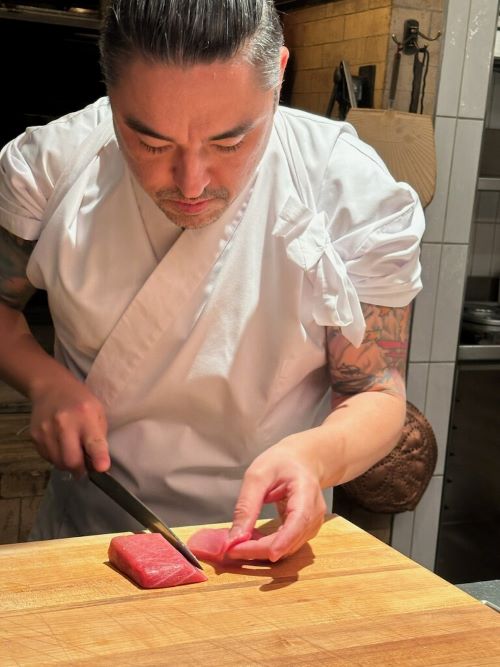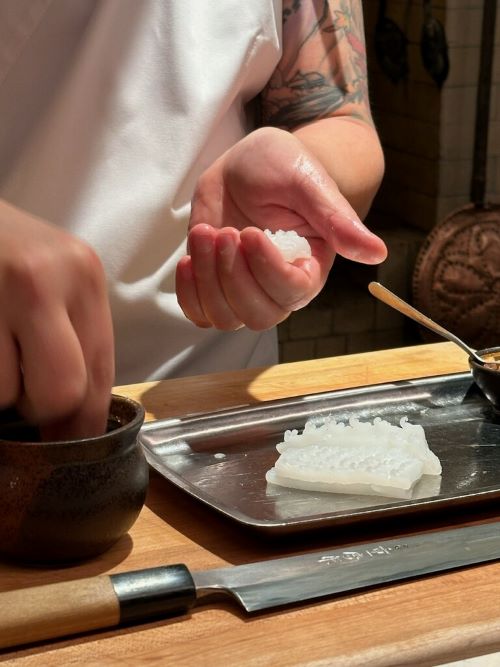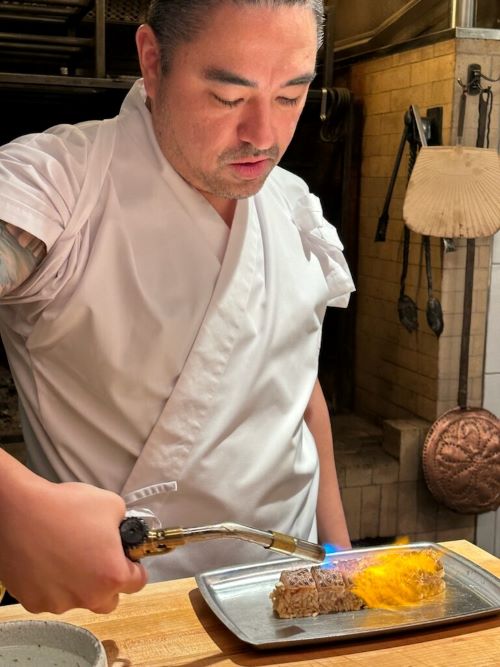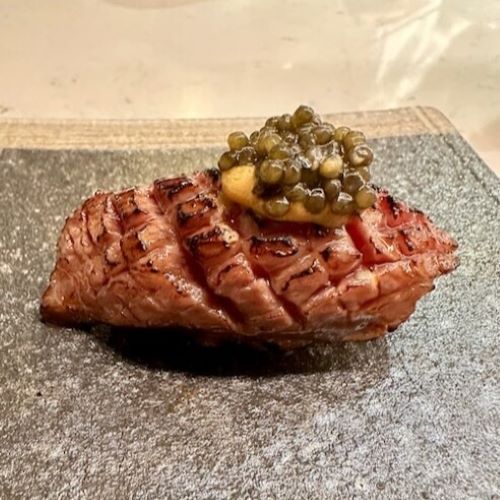Making the Midwest Sushi Connection For Omakase, Kansas City Chefs Look to Omaha
Published February 23rd, 2024 at 6:00 AM
Above image credit: James Beard Best Chef Midwest semifinalist David Utterback has made Omaha a top sushi destination. (Jill Wendholt Silva | Flatland)On a snowy night in January, as downtown Kansas City rushes to shutter stores and businesses, six sushi-curious diners arrive at The Town Company to await the start of the second 8:30 p.m. omakase seating.
Three food writers, a barbecue pitmaster, a former ramen restaurateur and his partner paid a non-refundable $265 for a one-night-only, 17-course omakase sushi experience. Omakase roughly translates to “I leave it up to you,” an improvised meal chosen by the chef based on the freshest ingredients and enjoyed as an artistic performance.
The chef preparing our meal is David Utterback, who wears his hair pulled back into a traditional Japanese topknot and a tasuki, a white sushi chef coat knotted tightly over his left shoulder, which pulls the sleeves up and emphasizes his richly detailed tattoo sleeves.

A self-trained, James Beard-nominated sushi chef of three Japanese restaurants in Omaha including Ota, an eight-seat omakase counter, Utterback spends the next three hours sharing stories that illustrate the finer points of nigiri, a style of sushi eaten in a single bite designed to “strip each raw ingredient down to its simplest, purest flavor.”
With ties to the premiere fish markets in Japan, Utterback’s menu includes the highest quality fish (such as $125 per pound tuna) and a chewier, doughy koshihikari rice flavored with the bold akasu vinegar, which he refers to as “the Pappy Van Winkle of vinegars,” but no sugar.
Most Midwesterners are more familiar with “big rolls with all the sauces and funky ingredients.” Utterback’s one-bite morsels pay homage to a traditional Japanese style created in Edo (now Tokyo) during the 1800s with a distinctly Midwestern point of view.
The son of a Japanese mother and an American father who made a career in the military, Utterback’s omakase displays playful invention with items like ika carbonara (squid sliced into noodles), an insanely decadent foie gras enriched rice and A5 wagyu strip loin from Hiroshima lightly torched then topped with a pat of sea urchin butter and buttery Beluga caviar.
“My sushi is super weird because I’ve never had a teacher to teach me or tell me not to do it. I put things together in ways they don’t normally go together,” he says. “Don’t tell the sushi police. I’m breaking the rules.”
Outside the Box
When the now 42-year-old former punk rock musician sold his guitars and set his sights on becoming a sushi chef a dozen years ago, there were only 10 omakase counters in the United States.
The online reservation service Resy now notes “restaurants specializing in sushi omakase have exploded across America.” Today, Utterback estimates there are more than 100 omakase counters in New York City alone.
Sushi-curious diners in Kansas City have spent the past year embracing upscale sushi with the opening of Kata Nori, an 18-seat hand roll bar at 404 E. 18th St. The highly anticipated Sushi Kodawari, an eight-seat omakase counter, also is under construction at 2100 Central St.
Tyler Harp of Harp Barbecue in Raytown snapped up an Ota reservation based on recommendations from top chefs and restaurant industry friends around Kansas City who have hosted one of Utterback’s pop-ups or made the three-hour drive to check out his restaurants. Rather than a deterrent, Harp sees the steep price tag as “an investment in knowledge.”
“That was one of the coolest experiences I’ve ever had anywhere,” Harp says. “What I take away from it, having a little bit of the knowledge of the accolades David has accumulated, is that you think Japanese fare is maybe buttoned up, but I was surprised by how out of the box everything was.”
Sushi Dreams
When asked about the rise in omakase and other styles of sushi, Utterback shares a link to The Untold Story of Sushi in America.
The New York Times story details the sushi craze of the 1980s, which was fueled by the vision and financial interests of the Rev. Sun Myung Moon, the Korean founder of the Unification Church and cult leader of the “Moonies,” whose followers were mostly Japanese.
“I grew up eating basically the same sushi everyone else was eating in the ‘80s to ‘90s,” Utterback says. Whether you lived in Kansas City or Omaha, “everyone has been eating the same sushi because 70% of the sushi bars were owned by Koreans.”

Utterback’s earliest memory of sushi was as a child celebrating his birthday at a restaurant in San Francisco’s Japan Town. A conveyor belt was filled with water and the sushi bobbed past diner on little boats.
“I don’t think my parents were paying attention and I racked up a very hefty bill for a 6-year-old,” he says with a laugh.
Fast forward to Utterback’s trip to Japan in 2009. He set out to eat the best sushi in Tokyo. The hotel concierge made him a reservation at Sukiyabashi Jiro. He paid $300 for 30 minutes of sheer bliss.
As the only diner in the restaurant, Utterback worked up the courage to tell the owner, Jiro Ono, and his son he was a sushi chef from America.
“They laughed longer than a joking laugh. It was a sort of full belly laugh and I died of embarrassment right there at the counter,” Utterback says.
Ono is the star of the 2011 documentary “Jiro Dreams of Sushi” and Sukyabashi Jiro is one the world’s most difficult reservations to snag.
As Utterback headed for the Ginza subway exit after his meal, he recalls “my mind had been blown. People just walked over me as I jotted down notes in my notebook. In that moment, everything had changed.”
Sushi Ambassadors
Eager for a restaurant of his own, Utterback and a bandmate cobbled together enough money to sign a lease to open the sushi spot Yoshitomo in 2017 in a former Subway sandwich shop, followed by Koji, a yakitori (skewered meat) restaurant, and Ota, a six-seat omakase counter, which has a waitlist of 50 every night.

While Omaha remains home for his family of a wife and two young children, Utterback has his sights set on adding a future restaurant concept in Kansas City.
“I just really love Kansas City. Omaha is a great food city, but Kansas City is the next step up,” Utterback says. “It has all the great things of Omaha, but more of it.”
When he was corporate chef at Blue Sushi Sake Grill, a chain in a dozen states, including locations Power & Light District and Woodside Village, Utterback would frequently eat lunch at Shio Ramen (closed in 2020).
Owner Patrick Curtis found Utterback engaging and offered his restaurants for pop-up events and invited Utterback to bunk at his house. He’s attended three omakase dinners and traveled with 2024 James Beard semifinalist Chef Romain Monnoyeur at Westport Café to Omaha to dine at Utterback’s Yoshitomo, a sushi and small plates venue.
“It’s hard to eat sushi anywhere else at this point,” Curtis says. “I appreciate the quality of the fish and I don’t know if I want to go to the place with a sushi conveyor belt. People ask me, ‘Where do I go for sushi? I say, ‘Omaha!’”
Passion’s Price Tag
During The Town Company pop-up, uni (sea urchin) is off the menu because the market price has gone through the roof. Instead, diners indulge in a rare treat. Utterback is one of only five chefs in the United States to procure tuna through a connection he refers to as “the god of tuna.”
“I often have a hard time describing to customers how rare this is,” he says.
At $125 per pound, the toro is the priciest fish we taste. The grouper at $65 per pound seems a more economical choice, yet there is considerable loss in yield after heads, bones and water is extracted through dry aging, a form of preservation popular in Japan before refrigeration. At which point, the price is back up to $125.
And that’s before labor is figured in.
“The best costs what it costs,” Utterback says.
Omakase Conundrum
Utterback is the only chef from Nebraska ever nominated for a prestigious James Beard award. If he wins, he would be the second sushi chef ever honored by the country’s premiere culinary foundation and the first Japanese American.
After a decade of hustling, booking his omakase through a network of text messages, Utterback is no longer worried about filling seats.

“Last year we made more money than we ever have,” he says. “But we raised prices and had less profit.”
Harp, who also popped up for several years before he opened his own restaurant, has quickly come to understand the financial challenges of a labor-intensive, protein-heavy menu that needs weekly adjustments to manage inflationary prices.
“Obviously, it’s hard to scale quality,” Harp says. “But if you are passionate about what you do, there are ways around it.”
Tamagoyaki, a rectangle of sponge cake based on the classic Portuguese pāo de Castella cake, signals the end of our meal, but not Utterback’s passionate pursuit of perfection.
“I only want to serve the best, no matter what,” he says. “There’s lot of mediocre product out there for a premium price, and not much technique. When you think of all of the stuff that goes into making just one piece of (omakase) sushi, any other kind of sushi is lazy.”
Jill Silva is a James Beard award-winning food editor and writer.


